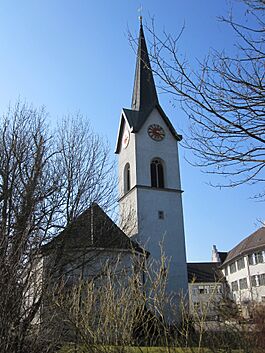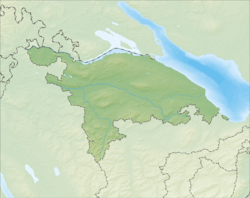Bürglen, Thurgau facts for kids
Quick facts for kids
Bürglen
|
||
|---|---|---|
 |
||
|
||
| Country | Switzerland | |
| Canton | Thurgau | |
| District | Weinfelden | |
| Area | ||
| • Total | 11.71 km2 (4.52 sq mi) | |
| Elevation | 441 m (1,447 ft) | |
| Population
(Dec 2020 )
|
||
| • Total | 3,953 | |
| • Density | 337.57/km2 (874.3/sq mi) | |
| Postal code |
8575
|
|
| Surrounded by | Berg, Birwinken, Bussnang, Kradolf-Schönenberg, Schönholzerswilen, Sulgen, Weinfelden | |
Bürglen is a town in Switzerland. It is located in the canton of Thurgau. Bürglen is part of the Weinfelden district.
Contents
History of Bürglen
Bürglen was first mentioned in old writings between 1282 and 1284. It was called Burgelon back then. A noble family, the Freiherrs of Bürglen, were first mentioned in 1176.
By 1350, all the land around the village was owned by one noble family. This area became known as the Herrschaft of Bürglen. A Herrschaft was like a small territory ruled by a lord.
In 1408, the Lords of Klingenberg took over the Herrschaft. Over the years, the land changed hands many times. In 1447, it went to the Baron of Sax-Hohensax. This family had owned land in Bürglen since 1360. By 1500, they had made Bürglen the center of their power.
However, in 1550, they had to sell it to the Breitenlandenberg family. Then, in 1579, the city of St. Gallen bought it. St. Gallen managed the village until 1798. They appointed a Vogt, who was like a local governor. The Vogt was in charge of the local court for Bürglen and several nearby villages.
Even though Bürglen was protected by walls around 1300, it was never officially a city. This was because of problems with the local nobles and competition from other towns. In 1528, a big fire destroyed much of the village. To rebuild, the villagers borrowed money from the Herrschaft. To help pay back the debt, they gave the Herrschaft rights to their shared land in 1540.
Under St. Gallen's rule, Bürglen lost much of its freedom. St. Gallen chose the local leaders and changed rules about inheriting land. However, the local farmers still had some independence. In the 17th century, they helped expand the castle and start new businesses. This led to a time of good fortune. But in the 18th century, new government rules made it harder for the village to grow. This also led to people becoming poorer.
Bürglen used to be part of the Sulgen church area. A village priest was mentioned in 1274. The castle chapel was finished in 1346. After the Protestant Reformation in 1529, the local court became Catholic again, but the village stayed Protestant.
In 1617, a priest from Neukirch an der Thur started serving Bürglen. Later, in 1676, the castle appointed the priest. In 1809, Bürglen and Andwil formed their own independent Protestant church area.
Geography of Bürglen
Bürglen covers an area of about 11.68 square kilometers (4.5 square miles). A large part of this land, about 62%, is used for farming. Forests cover about 17.5% of the area.
Buildings and roads make up about 17.3% of the land. Rivers and lakes cover about 2.6%. A small part, about 0.5%, is unproductive land.
Most of the built-up area is for industrial buildings, housing, and roads. There are also parks and sports fields. The forests are mostly dense woods, with some orchards and small groups of trees. All the water in Bürglen is flowing water, like rivers and streams.
The town of Bürglen is located in the Weinfelden district. It was created in 1995. This happened when the old towns of Bürglen, Leimbach, and Opfershofen joined together. Istighofen, which was part of Bussnang, also joined. Some other towns that used to be part of Bürglen, like Donzhausen, Hessenreuti, and Uerenbohl, became part of Sulgen in 1995.
People of Bürglen (Demographics)
Bürglen has a population of about 3,300 people. As of 2008, about 25% of the people living in Bürglen were from other countries. Over the past 10 years (1997–2007), the population has changed a little.
Most people in Bürglen speak German, about 84%. The next most common language is Albanian, spoken by about 6% of the people. Turkish is spoken by about 3% of the population.
In 2008, there were slightly more women than men in Bürglen. About 49.9% of the population were male, and 50.1% were female.
The population of Bürglen is growing. In 2008, there were more births than deaths. Also, more people moved into Bürglen than moved out. This means the total population increased by about 2.5% in 2008.
Here's a look at the age groups in Bürglen (as of 2009):
- About 8.9% of the population are children aged 0 to 9 years old.
- About 12.8% are teenagers aged 10 to 19.
- About 16% are young adults aged 20 to 29.
- About 12% are aged 30 to 39.
- About 16.7% are aged 40 to 49.
- About 14.8% are aged 50 to 59.
- About 8.9% are aged 60 to 69.
- About 5.9% are aged 70 to 79.
- About 3.5% are aged 80 to 89.
- A small number, about 0.5%, are 90 years old or older.
In 2000, there were 1,233 homes in Bürglen. On average, there were 2.6 people living in each home. Most of the buildings were single-family homes.
In the 2007 Swiss federal election, the most popular political party was the SVP. They received almost 40% of the votes.
Here is how the population of Bürglen has changed over time:
| year | population |
|---|---|
| 1450 | c. 250 |
| 1634 | 153 |
| 1682 | 435 |
| 1797 | 420 |
| 1850 | 442 |
| 1900 | 1,238 |
| 1950 | 1,714 |
| 1990 | 2,323 |
| 2000 | 3,197 |
Sights in Bürglen
The entire town of Bürglen is recognized as a Swiss Heritage Site. This means it has special historical and cultural importance.
Economy of Bürglen
In 2007, the unemployment rate in Bürglen was low, at 1.89%. This means most people who wanted jobs had them.
In 2005, there were 132 people working in the primary economic sector. This includes jobs like farming and forestry. There were 46 businesses in this area.
The secondary sector employed 483 people. This sector includes jobs in manufacturing and construction. There were 50 businesses in this sector.
The tertiary sector had 648 people working in it. This sector includes jobs in services, like shops, offices, and schools. There were 110 businesses in this sector.
In 2000, many people who lived in Bürglen worked outside the town. About 52% of residents commuted to other places for work. However, 718 people came into Bürglen to work. Most people used a private car to get to work, while about 10% used public transportation.
Religion in Bürglen
Based on the 2000 census, people in Bürglen follow different religions:
- About 30% are Roman Catholic.
- About 41% belong to the Swiss Reformed Church (a Protestant church).
- About 2.5% belong to the Orthodox Church.
- About 3.6% belong to other Christian churches.
- About 14% are Islamic.
- A small number of people belong to other religions or do not follow any religion.
Education in Bürglen
Most people in Switzerland are well educated. In Bürglen, about 61% of adults (aged 25–64) have finished high school or gone on to higher education, like university.
Bürglen has its own school district for primary and secondary schools. In the 2008/2009 school year, there were 278 students.
- There were 56 children in kindergarten.
- There were 96 children in the lower primary grades (ages 5-6).
- There were 126 children in the upper primary grades.
At the secondary level, students are grouped based on how well they learn. This level usually starts around age 12 and lasts for 3 years.
See also
 In Spanish: Bürglen (Turgovia) para niños
In Spanish: Bürglen (Turgovia) para niños






